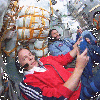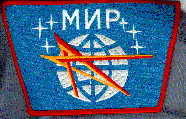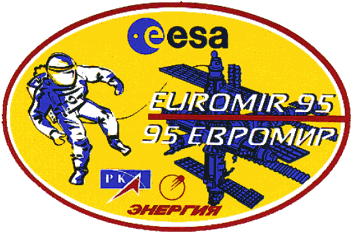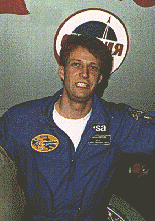
Anatoliy Y. Solovyev and Nikolai M. Budarin

by Ben Huset
September '95

Anatoliy Y. Solovyev and Nikolai M. Budarin
The C.I.S. manned space station Mir with MIR-19 cosmonauts Commander Anatoliy Y. Solovyev and Flight engineer Nikolai M. Budarin, Mir-20 Cosmonauts Yuri Gidzenko, Sergei Avdeyev and Thomas Reiter and will be appearing in the MN dusk skies August 12 to September 4th. then re-appearing in the morning skies September 20th to October 10th.

Yuri Gidzenko, Thomas Reiter and Sergei Avdeyev
Amateur radio operators can log into the Mir 'Packet' (R0MIR-1) BBS on 145.550 MHz.
The cosmonauts also use this freq. to talk with amateur radio operators on the ground during their off-hours.
For exact times and locations to see the space station over your backyard call MN MIRWATCH Coordinator Ben Huset at (612) 639-9109. This info is also available on the MN SFS computer BBS at (612) 459-0892 (300-14,400 baud). Look for MIRWATCH and other great space stuff on my web page at http://www.skypoint.com/members/benhuset/.
Astronauts and cosmonauts who participated in the historic link-up of the Space Shuttle Atlantis and the Russian space station Mir narrated a 16-minute IMAX film clip taken during the recently completed STS-71/Mir 18 mission. The special showing took place at the National Air and Space Museum's Langley Theater on Wednesday, August 2. Following the 16-minute film clip, the astronauts and cosmonauts took questions from the media. This event was later re-broadcast on NASA TV. You can DOWNLOAD several JPEGed IMAX images of Atlantis/Mir from http://shuttle.nasa.gov/sts-71/images/mir-imax/ or the MN SFS RBBS @ 612-459-1758.
I sure MISS the weekly TV Mir 'Mission Update' status reports and almost daily status reports from NASA while Norm was on-board. News from Mir is once again scarce. Hopefully things will get better during the STS-74/2nd Mir docking launch on October 26th.
PAINTINGS TO BE LAUNCHED TO MIR: ESA has agreed to launch some paintings to Mir. The cosmonauts and astronauts of Mir 19/20/STS-74 will select one to keep on board. The other paintings will be returned to Earth for a future international tour. One offering from each artist who submitted work to the project will also be recorded on a hard disk and sent to Mir.
The OURS Foundation of Embrach, Switzerland, is managing the Ars ad Astra, or Art to the Stars, competition and selected paintings to be launched to Mir as part of ESA's Euro-Mir '95 mission. The winning artist will receive a wristwatch that previously flew on Mir. ESA is paying for the Arts ad Astra exhibition through its public relations budget.
OURS invited artists to submit works on the theme of 'Space and Humanity' for the project. They received an enthusiastic response. More than 80 artists from the around the world submitted 171 works, ranging from a bawdy cartoon to an x-ray of a dead fish.
The chosen pieces had not only to display talent, but had to meet stringent size and weight requirements. The 20 works selected together weigh only 8.7 ounces. The artists were also required to use only non-toxic colors to protect the astronauts and to restrict the size of their paintings to a maximum eight by 12 inches.
Among the works chosen to hang weightless in the cosmos was one painting showing a grandfather and child gazing pensively at a starship headed toward Earth. In another, aborigines dance around a fire as a rocket takes off from its center. One work by German painter Peter Eickmeyer depicted three footprints. Also submitted was comic drawing showed a nude female astronaut tethered to a wall and trying to convince her partner to do the same. "Come on honey, it's the only way," read the caption. This piece was NOT selected.

The EuroMir'95/Mir-20 mission is currently scheduled for launch Sept. 3rd at 11:59 CET.
EUROMIR'95, the European Space Agency's second flight aboard Russia's Mir space station, will last a record-breaking 135 days and includes a spacewalk and some 40 scientific experiments.

Thomas Reiter @ Star City
The training program for ESA astronauts Thomas Reiter and Christer Fuglesang has been intense.
By the time the Soyuz rocket carrying the EUROMIR 95 astronaut lifts off its launch pad, the ESA astronauts will have received some 3,500 hours of mission training.
On March 17th, 1995, Reiter was named the prime crew member for the mission and Fuglesang member of the stand-by crew. Cosmonauts Yuri Gidzenko and Sergei Avdeyev round out the Mir-20 Crew.
Construction of most of the scientific equipment for EUROMIR '95 has only recently been completed, so much of the scientific training has taken place this year. The astronauts will use sophisticated European medical, technical and materials processing facilities. Much of the experiment training is taking place at the EAC, saving time and cutting the costs of sending scientists and equipment to Russia. Pre-flight baseline data collection, where the astronauts perform experiments as they would in space, allow scientists to compare ground-based results with those gathered later in space and also helps the astronauts become familiar with the experiments. The EUROMIR astronauts require a thorough understanding of the experiments, also because mission scientists cannot always be consulted when the station is out of communication range.
BOEING, KHRUNICHEV SIGN CONTRACT FOR SPACE STATION ELEMENT: Final agreement was reached on a $190 million contract for Russia to provide the first flight element of the international Space Station. The agreement signed by NASA's Space Station prime contractor, Boeing Defense & Space Group, and Russia's State Research and Production Space Center (Khrunichev) will lead to completion, delivery, launch, and on-orbit checkout in November 1997 of the Functional Energy Block -- or FGB -- a modified Russian space vehicle that will serve as the first building block for the on-orbit construction of the international Space Station.
The packet station, (PMS) aboard Mir appears to be in good shape, however, it has only been on the air for a few days during the whole month of July, and only 1 day in August. During one pass on August 7th at 10:40 UTC, packet from Mir was heard in Boston (145.550 MHz), but 1 hour later as Mir passed over N6JLH in California, the packet station on Mir was shut-down. Two days later, one of the crew was heard speaking Russian to someone in the USA. The crew seems only to be using the equipment during their "OFF" hours, and for a limited amount of time. It is hoped that when crew's work load eases up a bit, they will have more time/power to keep the station on line. The Mir crew sleeps from approximately 21:00 UTC till approximately 05:00 UTC (5pm-1am EST). Most of the Mir passes over the USA are during the sleeping period of the crew. Not much of an increase in Mir Amateur Radio activity is expected until the end of August. [Info via G. Miles Mann, WF1F]
Some issues relating to the Russian lease of the Baikonur cosmodrome in Kazakhstan remain unresolved. According to a Kazakh Radio report monitored by the BBC on 10 August. Legal experts on both sides are unable to compromise on two issues, namely cooperation between Kazakh and Russian law-enforcement bodies in the zone of the rocket launch site and settlements for lease payments. Negotiations on the mechanism for implementing the 20-year lease with an annual rent of $115 million are to be wrapped up by the beginning of September. In mid-April Kazakhstan's president ratified the agreement by decree; Russia ratified it in early May.
-30-
Return to:  September Downrange
September Downrange
Send Comments/Suggestions on this page to BenHuset@SkyPoint.com
Last Updated: August 31, 1995